engine Lancia Ypsilon 2002 Owner handbook (in English)
[x] Cancel search | Manufacturer: LANCIA, Model Year: 2002, Model line: Ypsilon, Model: Lancia Ypsilon 2002Pages: 191, PDF Size: 2.45 MB
Page 97 of 191

94
G
into the catalytic exhaust
pipe and damage it beyond
repair.
BUMP
STARTING
Bump starting by pushing, towing
or rolling downhill must be
avoided at all costs. This way of
starting could cause a rush of fuelRemember that as long as
the engine is not running,
the brake booster and
power steering do not work. You
therefore have to use considerably
more effort on both the brake
pedal and the steering wheel.
IF A TYRE
IS
PUNCTURED
GENERAL INDICATIONS
The following precautions must be
observed when changing a wheel and
using the jack and the space-saver
spare wheel.
4C090-119 ING 11-03-2008 12:00 Pagina 94
Page 99 of 191

96
G
Never fit a standard tyre to a rim
to be used for the space-saver
spare wheel. Have the punctured
tyre repaired and fitted back on as
soon as possible.
No more than one space-saver
spare wheel must be used at the
same time.
Do not grease the bolt threads be-
fore fitting them, they could un-
screw themselves.
The jack must only be used to
change wheels on the vehicle with
which it is supplied or on vehicles
of the same model. All other uses,
for example raising other vehicles,
must be excluded. Under no cir-
cumstances use the jack to carry
out repairs under the vehicle.
If the jack is not used correctly,
the raised vehicle may fall.Do not use the jack to lift weights
above that indicated on the label
attached to the jack itself.
Never start the engine while the
car is raised by the jack. If travel-
ling with a trailer, detach the
trailer before raising the car.
Snow chains cannot be fitted to
the spare wheel, consequently if a
front tyre is punctured (front drive)
and snow chains need to be fitted,
a standard wheel must be removed
from the back axle and the space-
saver spare wheel fitted in its
place. In this way there will be two
standard wheels on the front and
the snow chains can be fitted.
Incorrect fitting of the wheel hub
could result in the hub coming off
when the vehicle is travelling.Never tamper with the inflation
valve.
Do not insert any type of tool be-
tween the rim and the tyre.
Periodically check the tyre pres-
sure including that of the spare-
saver spare wheel as per the val-
ues given in “Technical Specifica-
tions”.
fig. 3
P4C00401
fig. 2
P4C00400
4C090-119 ING 11-03-2008 12:00 Pagina 96
Page 100 of 191

97
G
1. STOP THE CAR
– Stop the car so it is not a danger
for on-coming traffic and in such a
position that the tyre can be changed
in safety. The ground must be flat and
adequately firm. During the night,
chose a lit area, if possible.
– Turn engine off and engage the
handbrake.
– Engage first or reverse gear.
– Signal that the car is stopped ac-
cording to traffic regulations: hazard
lights, warning triangle, etc.
Any passengers must leave the car
and watch out for traffic while the
tyre is being changed.
If the ground is sloping or bumpy,
place wedges or other suitable mate-
rial for stopping the car under the
wheels.2. TAKE OUT THE TOOLS,
JACK AND SPARE WHEEL
(space-saver wheel)
They are in the boot.
– Lift the carpeting.
– Unscrew the fastener A (fig. 2)
and take out the tool holder.
The tool holder contains:
B- vehicle tow ring;
C- jack handle;
D- wheel bolt wrench;
E- screwdriver;F- extension for screwing wheel
bolts and inflation valve cap;
G- jack.
fig. 4
P4C00402
fig. 5
P4C00045
4C090-119 ING 11-03-2008 12:00 Pagina 97
Page 112 of 191
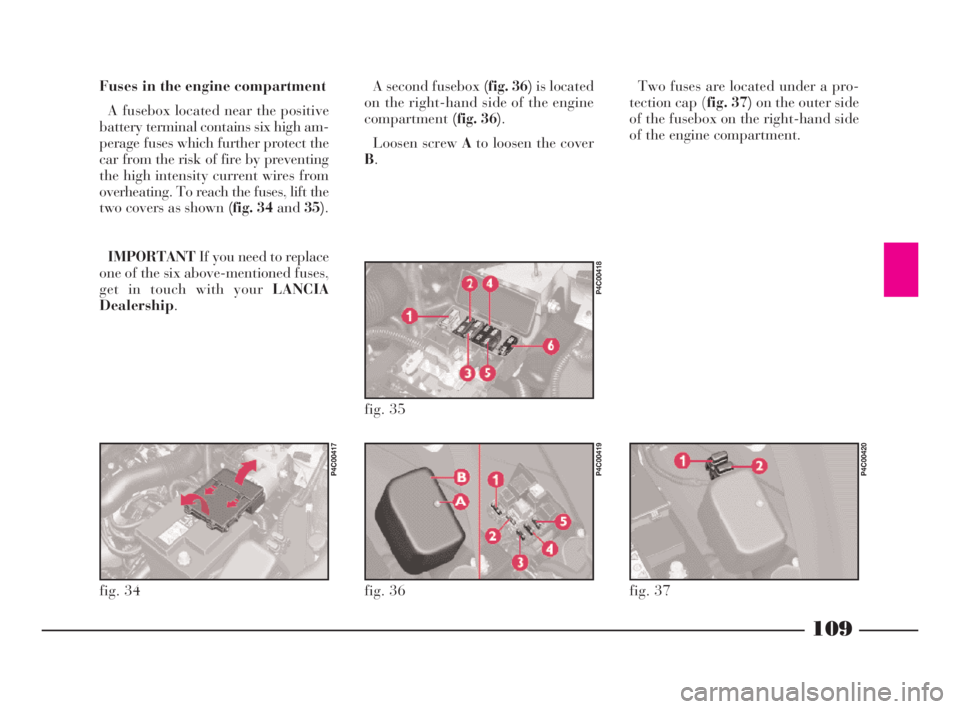
109
fG
Fuses in the engine compartment
A fusebox located near the positive
battery terminal contains six high am-
perage fuses which further protect the
car from the risk of fire by preventing
the high intensity current wires from
overheating. To reach the fuses, lift the
two covers as shown (fig. 34 and35).
IMPORTANTIf you need to replace
one of the six above-mentioned fuses,
get in touch with your LANCIA
Dealership.A second fusebox (fig. 36)is located
on the right-hand side of the engine
compartment(fig. 36).
Loosen screw Ato loosen the cover
B.Two fuses are located under a pro-
tection cap (fig. 37)on the outer side
of the fusebox on the right-hand side
of the engine compartment.
fig. 34
P4C00417
fig. 36
P4C00419
fig. 37
P4C00420
fig. 35
P4C00418
4C090-119 ING 13-03-2008 12:51 Pagina 109
Page 115 of 191
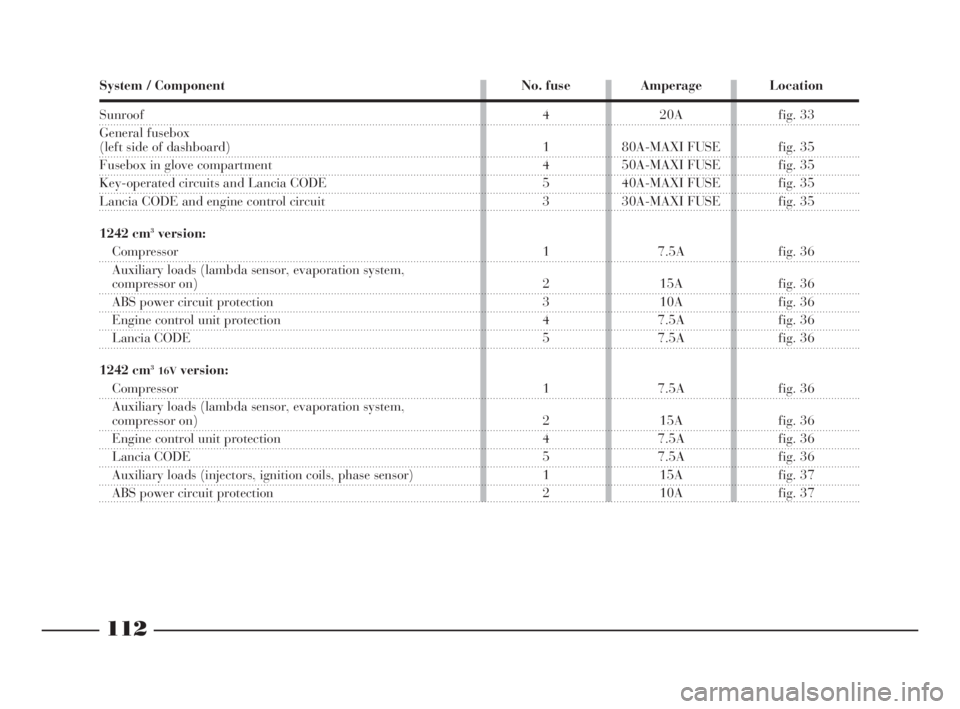
112
fG
System / Component No. fuse Amperage Location
Sunroof
General fusebox
(left side of dashboard)
Fusebox in glove compartment
Key-operated circuits and Lancia CODE
Lancia CODE and engine control circuit
1242 cm
3version:
Compressor
Auxiliary loads (lambda sensor, evaporation system,
compressor on)
ABS power circuit protection
Engine control unit protection
Lancia CODE
1242 cm
316Vversion:
Compressor
Auxiliary loads (lambda sensor, evaporation system,
compressor on)
Engine control unit protection
Lancia CODE
Auxiliary loads (injectors, ignition coils, phase sensor)
ABS power circuit protection4 20A fig. 33
1 80A-MAXI FUSE fig. 35
4 50A-MAXI FUSE fig. 35
5 40A-MAXI FUSE fig. 35
3 30A-MAXI FUSE fig. 35
1 7.5A fig. 36
2 15A fig. 36
3 10A fig. 36
4 7.5A fig. 36
5 7.5A fig. 36
1 7.5A fig. 36
2 15A fig. 36
4 7.5A fig. 36
5 7.5A fig. 36
1 15A fig. 37
2 10A fig. 37
les
00
ed
az-
ve
4C090-119 ING 13-03-2008 12:51 Pagina 112
Page 116 of 191
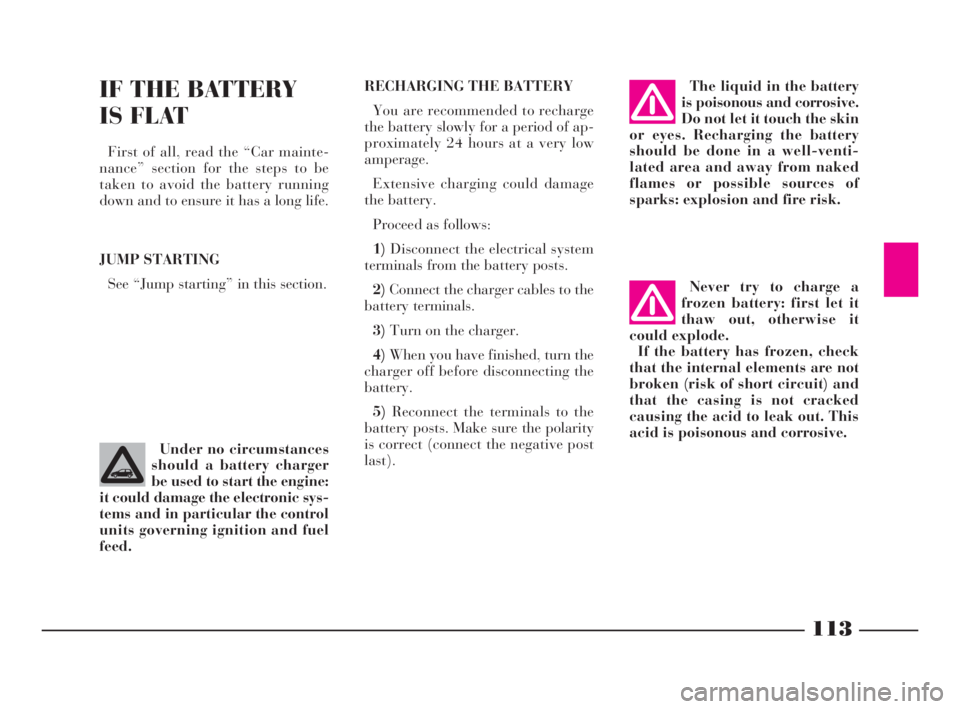
113
fG
RECHARGING THE BATTERY
You are recommended to recharge
the battery slowly for a period of ap-
proximately 24 hours at a very low
amperage.
Extensive charging could damage
the battery.
Proceed as follows:
1)Disconnect the electrical system
terminals from the battery posts.
2)Connect the charger cables to the
battery terminals.
3)Turn on the charger.
4)When you have finished, turn the
charger off before disconnecting the
battery.
5)Reconnect the terminals to the
battery posts. Make sure the polarity
is correct (connect the negative post
last).IF THE BATTERY
IS FLAT
First of all, read the “Car mainte-
nance” section for the steps to be
taken to avoid the battery running
down and to ensure it has a long life.
JUMP STARTING
See “Jump starting” in this section.The liquid in the battery
is poisonous and corrosive.
Do not let it touch the skin
or eyes. Recharging the battery
should be done in a well-venti-
lated area and away from naked
flames or possible sources of
sparks: explosion and fire risk.
Never try to charge a
frozen battery: first let it
thaw out, otherwise it
could explode.
If the battery has frozen, check
that the internal elements are not
broken (risk of short circuit) and
that the casing is not cracked
causing the acid to leak out. This
acid is poisonous and corrosive.
Under no circumstances
should a battery charger
be used to start the engine:
it could damage the electronic sys-
tems and in particular the control
units governing ignition and fuel
feed.
4C090-119 ING 13-03-2008 12:51 Pagina 113
Page 120 of 191

117
fG
While the car is being
towed with the engine off,
remember that the brake
pedal and steering will require
more effort as you no longer have
the benefit of the brake booster
and power steering. Do not use
flexible cables to tow. Avoid jerk-
ing. Whilst towing, ensure that the
coupling to the car does not dam-
age the surrounding components.Do not extract the igni-
tion key during towing;
leave it at MAR, to prevent
the steering lock engaging and,
provided the electrical system is
not damaged, keep the brake lights
and direction indicators working.
When the ignition key is re-
moved, the steering lock will cut in
thus preventing the steering wheel
from being turned.IF AN ACCIDENT
OCCURS
– It is important to keep calm.
– If you are not directly involved,
stop at least ten metres away from the
accident.
– If you are on a motorway do not
obstruct the emergency lane with your
car.
– Turn off the engine and turn on
the hazard lights.
– At night, illuminate the scene of
the accident with your headlights.
– Act carefully, you must not risk
being run over.
– Mark the accident by putting the
red triangle at the regulatory distance
from the car where it can be clearly
seen.
– If the doors are jammed, do not try
to leave the car by breaking the glass
of the windscreen as the glass is strat-
ified. Side windows and the rear win-
dow can be broken more easily.
4C090-119 ING 13-03-2008 12:51 Pagina 117
Page 126 of 191
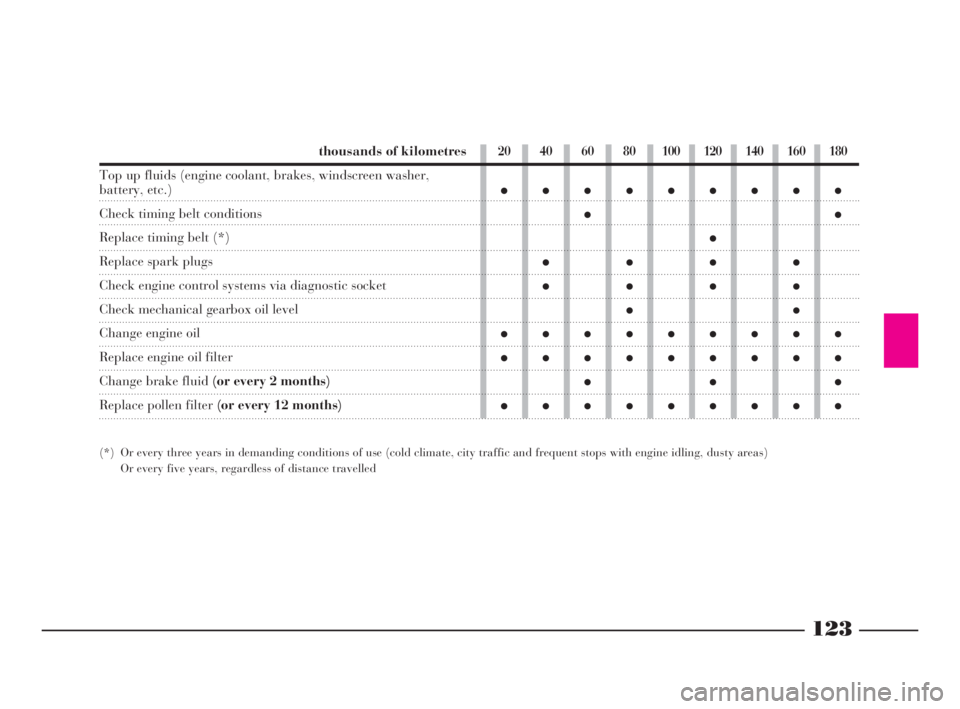
123
G
thousands of kilometres
Top up fluids (engine coolant, brakes, windscreen washer,
battery, etc.)
Check timing belt conditions
Replace timing belt (*)
Replace spark plugs
Check engine control systems via diagnostic socket
Check mechanical gearbox oil level
Change engine oil
Replace engine oil filter
Change brake fluid (or every 2 months)
Replace pollen filter (or every 12 months)
(*) Or every three years in demanding conditions of use (cold climate, city traffic and frequent stops with engine idling, dusty areas)
Or every five years, regardless of distance travelled
20 40 60 80 100 120 140 160 180
●●●●●●●●●
●●
●
●●●●
●●●●
●●
●●●●●●●●●
●●●●●●●●●
●●●
●●●●●●●●●
4C120-143 ING 11-03-2008 12:01 Pagina 123
Page 127 of 191
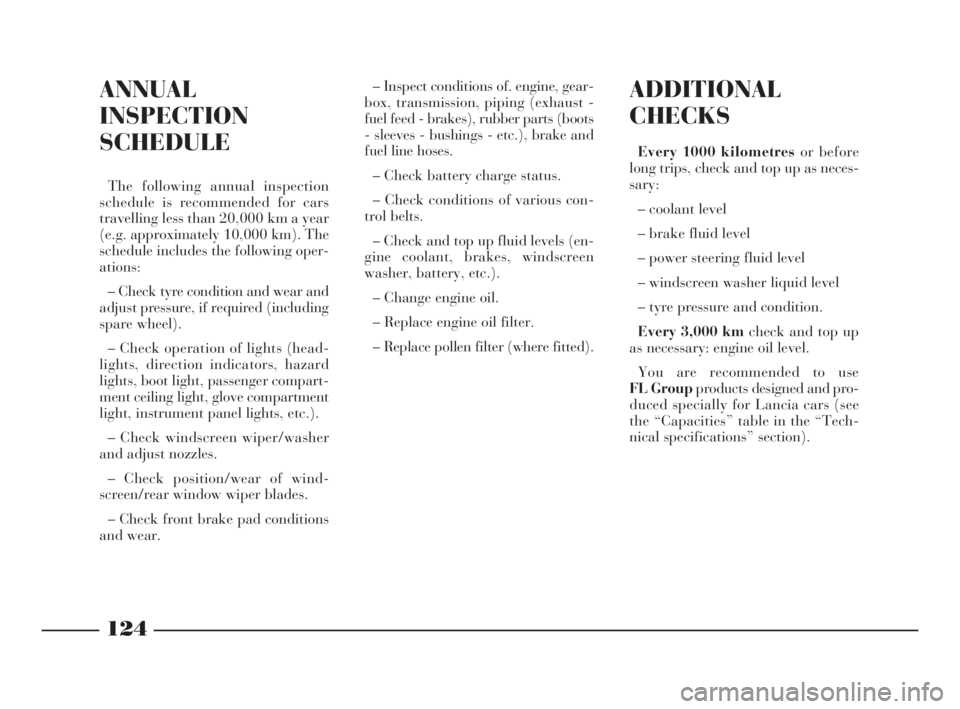
124
G
ADDITIONAL
CHECKS
Every 1000 kilometres or before
long trips, check and top up as neces-
sary:
– coolant level
– brake fluid level
– power steering fluid level
– windscreen washer liquid level
– tyre pressure and condition.
Every 3,000 kmcheck and top up
as necessary: engine oil level.
You are recommended to use
FL Groupproducts designed and pro-
duced specially for Lancia cars (see
the “Capacities” table in the “Tech-
nical specifications” section).
ANNUAL
INSPECTION
SCHEDULE
The following annual inspection
schedule is recommended for cars
travelling less than 20,000 km a year
(e.g. approximately 10,000 km). The
schedule includes the following oper-
ations:
– Check tyre condition and wear and
adjust pressure, if required (including
spare wheel).
– Check operation of lights (head-
lights, direction indicators, hazard
lights, boot light, passenger compart-
ment ceiling light, glove compartment
light, instrument panel lights, etc.).
– Check windscreen wiper/washer
and adjust nozzles.
– Check position/wear of wind-
screen/rear window wiper blades.
– Check front brake pad conditions
and wear.– Inspect conditions of. engine, gear-
box, transmission, piping (exhaust -
fuel feed - brakes), rubber parts (boots
- sleeves - bushings - etc.), brake and
fuel line hoses.
– Check battery charge status.
– Check conditions of various con-
trol belts.
– Check and top up fluid levels (en-
gine coolant, brakes, windscreen
washer, battery, etc.).
– Change engine oil.
– Replace engine oil filter.
– Replace pollen filter (where fitted).
4C120-143 ING 11-03-2008 12:01 Pagina 124
Page 128 of 191
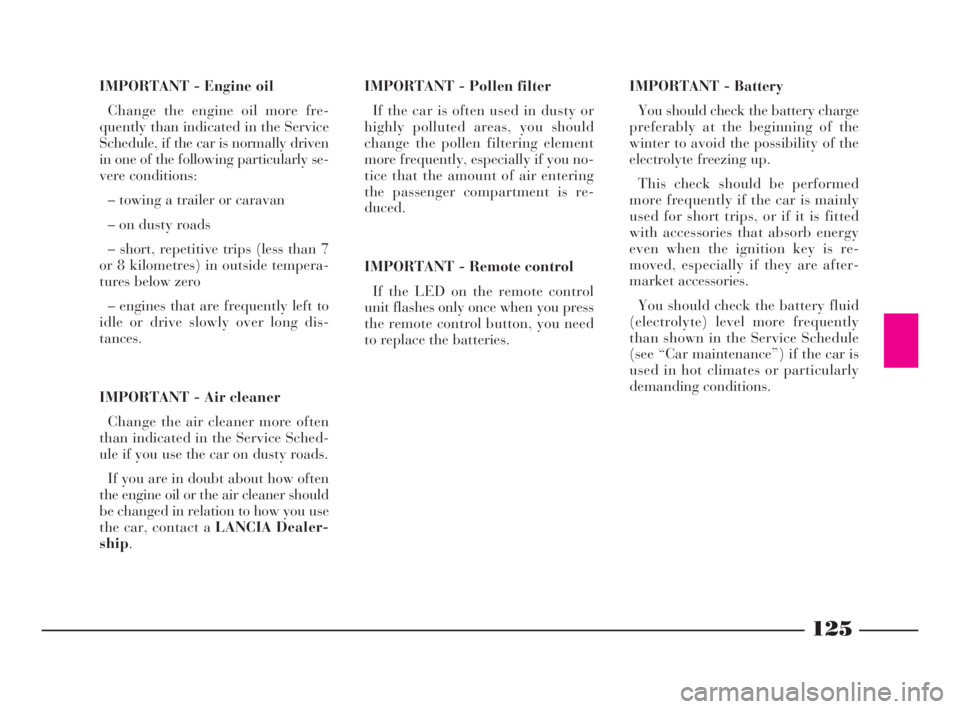
125
G
IMPORTANT - Battery
You should check the battery charge
preferably at the beginning of the
winter to avoid the possibility of the
electrolyte freezing up.
This check should be performed
more frequently if the car is mainly
used for short trips, or if it is fitted
with accessories that absorb energy
even when the ignition key is re-
moved, especially if they are after-
market accessories.
You should check the battery fluid
(electrolyte) level more frequently
than shown in the Service Schedule
(see “Car maintenance”) if the car is
used in hot climates or particularly
demanding conditions. IMPORTANT - Engine oil
Change the engine oil more fre-
quently than indicated in the Service
Schedule, if the car is normally driven
in one of the following particularly se-
vere conditions:
– towing a trailer or caravan
– on dusty roads
– short, repetitive trips (less than 7
or 8 kilometres) in outside tempera-
tures below zero
– engines that are frequently left to
idle or drive slowly over long dis-
tances.
IMPORTANT - Air cleaner
Change the air cleaner more often
than indicated in the Service Sched-
ule if you use the car on dusty roads.
If you are in doubt about how often
the engine oil or the air cleaner should
be changed in relation to how you use
the car, contact a LANCIA Dealer-
ship.IMPORTANT - Pollen filter
If the car is often used in dusty or
highly polluted areas, you should
change the pollen filtering element
more frequently, especially if you no-
tice that the amount of air entering
the passenger compartment is re-
duced.
IMPORTANT - Remote control
If the LED on the remote control
unit flashes only once when you press
the remote control button, you need
to replace the batteries.
4C120-143 ING 11-03-2008 12:01 Pagina 125